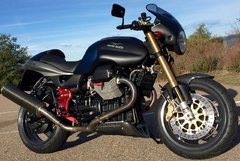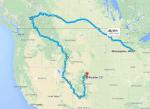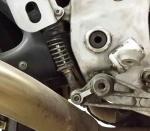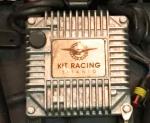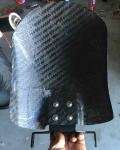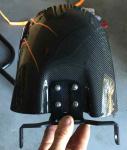-
Posts
4,123 -
Joined
-
Last visited
-
Days Won
253
Content Type
Profiles
Forums
Events
Gallery
Community Map
Everything posted by Scud
-
Thought it was time for a sorting update. I've been busy fretting over oil pressure: http://www.v11lemans.com/forums/index.php?showtopic=19114 But meanwhile, I've been commuting and taking some short rides. Everything seems to be fine. I did a leisurely 200 miles today with a buddy who has a Harley. Played accordion a little - catch the traffic on the curves, wait for Harley on the straights, catch, wait, catch, wait... kind of fun game actually. As for running smoothly, I did not manage to tune-out the minor hiccup. Then I thought - why not disconnect the temperature sensor and see what happens? That's how the bike was when I got it; it was running great then. http://www.v11lemans.com/forums/index.php?showtopic=18960 Whaddya know - it runs sweet with the sensor disconnected. "If ya can't beat 'em, join 'em." I did test the resistance of the engine and air temperature sensors, both were at 3.3k ohms at room temperature. Not sure what's going on here, but I'm also getting 40.7 MPG (per today's ride) so I guess I'll leave it unhooked. In other news, I finally sold my Honda CB350-Four. So it may be play time again soon. The fiberglass belly pan (Ghezzi-Brian) and billet levers (Harpers) are awaiting reddening and darkening (respectively). And I set a new record today. Three whole pies... Couldn't even do that on my ex-BMW RT.
-
Guzzi virus is good for you. Singapore is crazy expensive on vehicles. Isn't there a way to keep a bike or two in Malaysia?
-
My price is very low. I'm just thirsty... six-pack plus shipping should cover it. People who don't have a broken ITI - it's probably because they have a broken Veglia instead.
-
K&N vs. paper seems to be a bit polarizing. On my Scura, I removed (but no cutting) the rubber snorkels and installed the same K&N you referenced. There's lots of "bad press" for K&N, but then there are people such as Docc, who are pushing 100,000 miles with K&N filters. On my Lemans, I got rid of the PO's K&N pods and reinstalled the factory airbox without snorkels, and with a paper filter - mostly because I had a new paper filter and was too cheap to buy another K&N. I'd be interested to see the data about the snorkels. Intuitively, it seems that they can only be a hindrance. But that's why people conduct experiments - so we don't have to rely on intuition.
-
I have one. Do you have any beer? PM sent.
-
There's certainly some dirt and debris in the filter, just not enough to bother cleaning it yet. You can see in the picture of the filter above that the left looks dirtier than the right - that's because of the angle of camera. On the left you see the side of the pleats that face the intake. It's only been in there 6 months or so. So, if by worry you mean you're concerned that the dirt has slipped by the filter. No, I'm not worried about that. It's been fairly wet this year and all my rides have been on asphalt - no dust storms either. That being said - when I got my Husky 450, the PO had a K&N on it (he mostly rode it on the street). I ditched that immediately for standard foam filters - the Husky gets dirty. I assume you're running foam filters on that lovely 640 adv. They stay clean when you're riding in the snow, right? Like in your profile pic. I love snow-rides...
-
Being a curious sort, I pulled the K&N off my Scura after 6,000 miles of use. It still looks nearly new, but I could tell that the leading edges of the pleats were a bit dirtier than trailing edges, so I spun it around 180 degrees. Interestingly, K&N recommends inspecting it after 25,000 miles if used in the factory airbox - and claims some go 50,000 between cleanings - pics here: http://www.knfilters.com/cleaning.htm Tank removal - I use a simple siphon to get the gas out when I'm ready, rather than trying to run it low (which still leaves pretty close to a gallon in the tank)
-
There are 5 relays. Apparently, they are one of a few known weak points. Upgrading all 5 right away just saves you from future worry. See Docc's post above for a link to order them. $25 and 5 minutes of labor - then you'll probably never have to think about them again. Will you be taking the scenic route?
-
Are we talking about Judas Priest's vocalist Rob Halford? Like the best metal singer of all time!?!?!?
-
Congratulations. I rode in the Rockies recently on a rented BMW. I was itching for my Guzzi. Have fun with it up there. I was curious about a travel kit too - this thread has lots of good ideas: http://www.v11lemans.com/forums/index.php?showtopic=18860 Oil level - heaps of opinions on this. I've been using a gallon of oil. Basically, the dipstick is a "X" shape in cross-section, it has two rings at low and full levels. I think a lot of people keep the oil a little above the full mark. Seems there is some variation in production, so some people calibrate their dipsticks when they have the pan off. +1 on the Roper plate. Fuel tank is over 5 gallons (as noted above), about 4.5 of which are usable (due to shape of tank). I agree that easy highway running should get you close to 40mpg (I tried that once... zzzz...). Gas every 150 miles (again assuming not too much stop and go) is safe and easy to remember. The low-fuel warning light helps... Definitive recommended settings? There are several different definitive recommended settings. I'm running .007 Intake and .010 Exhaust.
-
John - Thanks for that. I took a screen shot and uploaded it. That's a clever spot for the spring. I was imagining something on the front that pulled the lever up; your solution seems so obvious now. I think I might use the rear brake accidentally sometimes - just by letting my foot get lazy. Or that I might use it unconsciously sometimes - carryover of dirt bike habits. A stiffer pedal should "cure" me of those habits. Anyway - I just had this hot brake problem once that I am aware of.
-
A friend of mine put something like this on his KTM rear brake - said it helped. Maybe something like this can be adapted? http://slavensracing.com/shop/brake-caliper-cooler-ktm-husaberg/
-
Where, exactly, did you put the spring? (a picture would be nice if it's convenient for you) I wonder if the brake could be "auto-engaging" when the bike goes over bumps. Could the pedal bounce enough to put just a bit of pressure on? This could explain why the spring helped so much. This could be my problem too, as I didn't think I was using the rear brake very much. FYI - I don't think I boiled the fluid and I didn't lose pressure - just noticed that rotor was quite hot.
-
I overheated my rear brake midway on a 400 mile loop with lots of elevation changes. When I noticed it (after a major descent), I just rode about 50 miles without touching the rear brake - checked again and it was better.
-
Here's the MG Kit Racing ECU on my LeMans. Titanio - lovely Italian word. As I understand it, the ECUs were not actually different than stock; they just had a different map loaded on them. Someday I will connect to GuzziDiag and join the rest of the discussion...
-
AMA = American Medical, Management, or Motorcyclist Association. The M in AMA almost always means medical in US conversations - probably as it does in Australia. But on this forum, I think we can assume the M will be for Motorcycle. Here's AMA's take on lane-splitting (which I do lot): http://americanmotorcyclist.com/rights/positionstatements/lanesplitting.aspx And wikipedia's take on it: https://en.wikipedia.org/wiki/Lane_splitting How'd you like to be able to legally ride up to the front of every red light and get the hole-shot on every green light? I love it... seriously shortens travel time. IMO, it should be legal everywhere. AMA supports legislation to make it possible.
-
I'm an AMA member; have been for a while. I see it sort of like a charitable contribution, but I sometimes get discounts because of the membership. The magazine that comes along with it is usually worth reading. They lobby for motorcyclists' rights and try to keep riding areas open (for dirt bikes) - stuff I appreciate but don't have time to get informed about. I think AAA is different in each state. In California, the RV option includes motorcycle retrieval/hauling. Maybe that's the same where you live and the rep didn't know about it. The basic membership gives the free towing, gas, unlock your car, etc. I upgraded to a level that provides up to 100 miles of towing for any vehicle - the probability of breaking an Italian motorcycle within 25 miles of a good place to get it fixed is quite low.
-
Update - I managed to get a mechanical oil pressure gauge connected today (test kit). I got the same readings as posted before, which just confirms the accuracy of the gauge I installed. So there's one more thing off the list... and I got a new tool, so that's always a good day. Good looking mount, dontcha think? Meanwhile, I've been riding it almost every day - mostly my short commute - and it's doing fine.
-
Installed the fender today. Here's why it's better than the old one: Thicker bracket material - does not bounce like the old one and I expect that the bracket will not break It no longer rubs on the lower shock mount It comes with sturdier mounting hardware Critical comments/mods required: The bracket needed to be reamed out for the shock bolt to pass through it It seems that it could do with bigger washers - so I got some It's still tricky to get it aligned correctly (holes not pre-drilled) The fender itself still has an odd curve in it as Jaap noted earlier. I mounted the fender to the bracket before installing it this time (much easier than installing bracket first). These pics show how the fender needs to align to the bracket in order to look straight when installed. As for function - I've been running the stock fender on the Scura and noticed that it does get dirtier with the stock fender, so even if it's only to prevent road debris from accumulating, especially on the shock, I'm happy to have it back on. I still think it looks cool.
-
Another one of those crazy owners of low mile special edition bikes that goes balls out on the mods! hehehe (JUST KIDDING SCUD BUDDY!) I mean, honestly... who would put so much money and effort into a bike and then not ride it farther than their tank of ethanol-free gas will take them? (batting it back over the net to you...)
-
I believe I've seen a few people write about how much they want a Coppa Italia... here's your chance: http://portland.craigslist.org/clc/mcy/5137009055.html Not even 3,000 miles, heaps of tasteful upgrades. $10,000.
-
I got chewed out for suggesting something like that once before. All Guzzi's are limited production. Having a numbered plaque is not required. Some are less common than others, having a numbered plaque has little to do with it. My '93 Daytona is probably rarer than a Scura, my wifes Lario is probably rarer still. But that has little to do with how much fun they all are to ride. I enjoy riding ALL my Guzzi's, and would happily enjoy riding yours if you want to lend it to me ;-) Can't we all just get along????? They are all rare. I did a little rough math over at the LeMans Registry: http://www.v11lemans.com/forums/index.php?showtopic=17535&page=3 The number plaque makes it seem more rare. I admit, it's kind of fun to show off when people ask about the Scura: "Look it's so rare that they numbered them..." Maybe I'll stick a plaque on the LeMans for entertainment value. Let me know when you're in the area. I'll show you a few mountain roads and you can show me how to lean a bike until the front axle nut drags around the corners...
-
Thanks for the data, which makes it easier to find other compatible fuel caps. This site shows all the bikes that the Oberon 0421 will fit: http://motowheels.com/i-6922330-oberon-billet-fuel-cap-aprilia-triumph.html Too bad they don't have all-black... I've been casually eyeing a couple options by Driven Racing. With Driven, you buy a base to fit your bike, then choose a color cap and buy that separately. Thanks to Steve, I know what bike to pretend I have when placing an order. http://www.revzilla.com/motorcycle/driven-halo-fuel-cap-base-triumph-daytona-675-955i-street-triple http://www.revzilla.com/motorcycle/driven-racing-d-axis-fuel-cap-base-for-triumph
-
Scura were numbered with plaques on the top triple clamp (mine says S375), but it seems that they were more common than many of the non-numbered bikes. I added the one for sale to the Scura Register (aka therapy group)... wait, isn't this whole site a therapy group? I know I feel better since joining...


